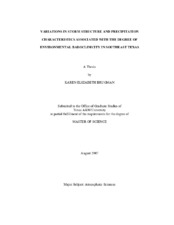| dc.description.abstract | The large-scale environment can have a significant impact on subtropical precipitating systems via the baroclinicity of the environment and the associated dynamical forcings. The degree of baroclinicity is examined using National Centers for Environmental Prediction (NCEP) reanalysis temperature and zonal wind fields over a two-year period for Southeast Texas, yielding classifications of barotropic, weakly baroclinic, and strongly baroclinic for the background environment. Weakly baroclinic environments accounted for half of the days throughout the two-year period. Barotropic environments occurred most frequently during summer and strongly baroclinic environments occurred most frequently in winter, although less often than weakly baroclinic environments. A climatology of storm types, based on dynamical forcing (i.e., weak forcing, drylines, cold fronts, warm fronts, stationary fronts and upper level disturbances) and precipitation structure (i.e., isolated, scattered, widespread, linear, unorganized and leading-line/trailing stratiform), was compiled and compared to the baroclinicity designations. Non-frontal storm types (i.e., weak forcing, drylines and upper level disturbances) are typical of barotropic environments, while frontal storm types (i.e.,warm, cold and stationary fronts) are typical of weakly and strongly baroclinic environments. Storm events and drop-size distributions (DSD) were identified from surface rainfall data collected by a Joss-Waldvogel disdrometer located in College Station, Texas. The DSDs were compared by baroclinicity and storm type. The barotropic DSD is weighted towards the largest drops because of the stronger convection and stratiform precipitation in the weak forcing and dryline storm types, while the strongly baroclinic DSD is weighted towards the smallest drops because of the weaker convection from the warm fronts and stationary fronts. The weakly baroclinic DSD is weighted more evenly towards small and large drops than the barotropic and strongly baroclinic DSDs because of the conflicting microphysical processes in the different storm types. The microphysical processes within the storms vary by storm type and baroclinicity regime, such that the large-scale environment modifies the precipitation characteristics of storms in SE Texas. | en |


